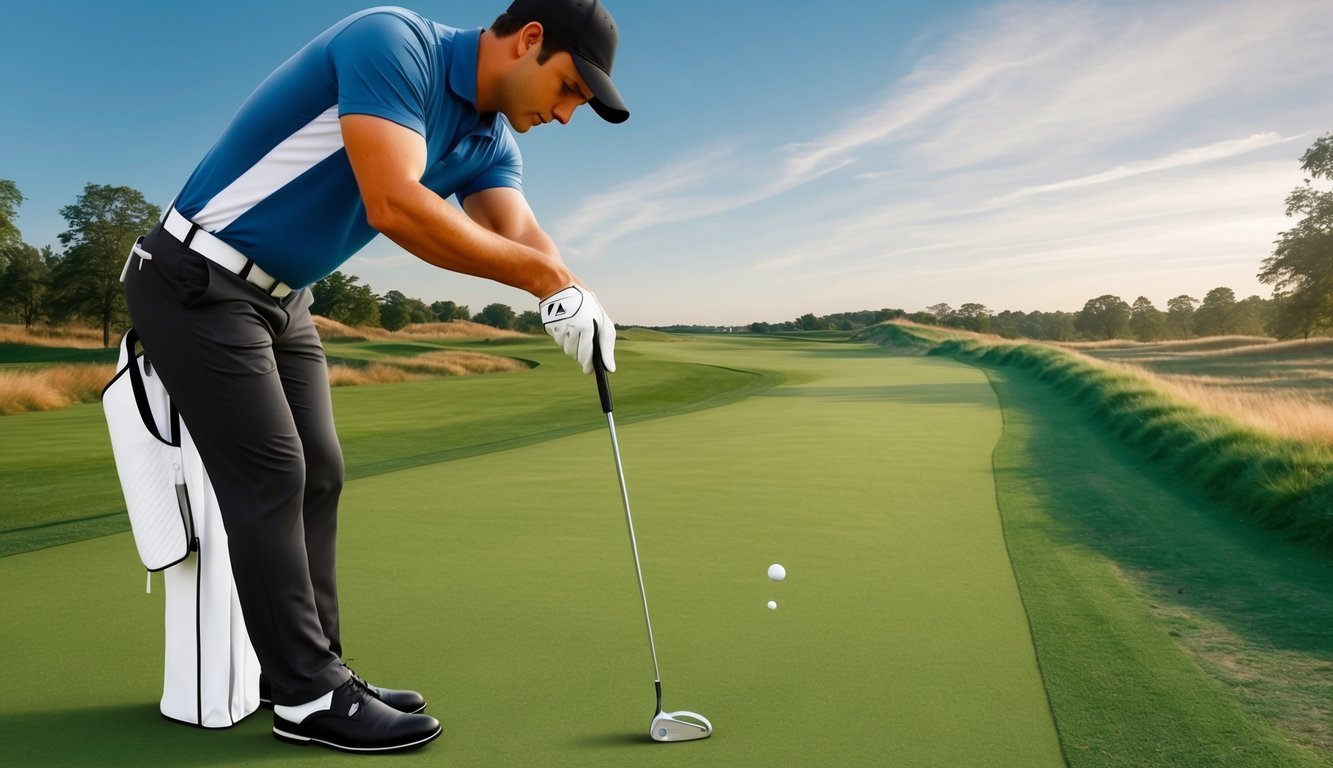Navigating the nuances of golf can be both challenging and rewarding.
One of the trickiest scenarios you may encounter is a tight lie, where the ball rests on minimal grass, demanding both precision and skill. To conquer a tight lie, you must master the necessary techniques and choose the right equipment.

In this post, you’ll uncover how to approach a tight lie effectively, boosting your game and building confidence.
Whether you’re using specialized clubs or adjusting your stance, each decision can significantly impact your shot outcome. By strategically managing your course tactics, you can overcome the difficulties posed by these challenging lies.
Key Takeaways
- Understand the essentials of tackling a tight lie for better performance.
- Equip yourself with suitable clubs to increase shot precision.
- Develop strategic course management to handle difficult scenarios.
Understanding a Tight Lie
When dealing with a tight lie in golf, mastering the right technique can make all the difference.
A ball resting on a tight lie can present unique challenges due to the minimal grass coverage and firm ground underneath. It is important to understand the specific characteristics of a tight lie and common mistakes to avoid.
Characteristics of a Tight Lie
A tight lie is where the golf ball sits on minimal grass, making contact primarily with bare or firm ground.
This situation often occurs on closely-mown areas such as fairways.
The lack of cushion beneath the ball can make it more difficult to hit cleanly.
Playing from a tight lie demands precision.
The clubhead must strike the ball accurately without catching too much ground before contact.
This is harder to accomplish on a hardpan lie, where the ground is especially firm and compact. It’s essential to remain patient and conscious of the ball’s position to execute the shot effectively.
Common Mistakes on Tight Lies
One frequent mistake when addressing a ball on a tight lie is attempting to scoop it into the air, which can result in thin or topped shots.
Keeping your hands ahead of the clubface to ensure a descending blow is crucial.
Another mistake is choosing a club with too much loft.
While it might be tempting to use a wedge to get the ball airborne quickly, it often leads to poor contact with the ball.
Instead, opt for a club with more punch for better control.
Avoid overcommitting to power.
Swinging too hard can disrupt your tempo and balance, leading to mishits. Focus on maintaining a steady tempo and making solid contact.
The Technical Aspect
Addressing a tight lie in golf requires adjusting key elements like the stance, grip, and swing mechanics.
Understanding how to position the ball and manage your weight can significantly influence the success of your shot.
Adjusting Your Stance and Grip
When dealing with a tight lie, your stance and grip can make a big difference.
Start by positioning the ball slightly back in your stance.
This helps ensure that you make contact with the ball first before the ground.
Keep your weight slightly forward, leaning towards your front foot, which aids in maintaining control.
Ensure your grip is firm but not tense.
A consistent grip pressure helps stabilize the clubface during the swing.
This stability is essential for controlling the direction and distance of your shot. An adjusted grip also helps in managing the shaft angle, which influences the trajectory of your shot.
Swing Mechanics and Ball Position
The swing mechanics are crucial for hitting a successful shot from a tight lie.
Focus on a shorter backswing to maintain better control.
A controlled tempo in both the backswing and downswing is important to avoid over-hitting.
During the downswing, focus on keeping your hips stable, allowing your arms to guide the clubhead efficiently.
Ball position is key; placing it back in your stance can facilitate a downward strike, essential for compact or bare ground. This technique helps minimize the risk of mishitting the ball or digging too much into the ground.
Maintain a steady follow-through to ensure that you make clean contact, aiming for a solid impact where the clubface meets the ball effectively.
Club Selection and Usage

When playing golf on tight lies, selecting the right club and using it effectively are crucial skills.
Your choice of club can significantly influence how you navigate challenging surfaces and impact your overall performance on the course.
Choosing the Right Club
Selecting the appropriate club mostly depends on the lie and desired shot.
For chipping off tight lies, a pitching wedge or sand wedge is often suitable.
These clubs give you enough loft to clear obstacles while maintaining control.
Using a club with less bounce helps reduce the likelihood of the club bouncing off the ground. A well-chosen club ensures greater precision and enhances your ability to execute the shot with confidence.
For longer shots, hybrids or fairway woods can be useful.
These clubs often offer a favorable mix of distance and forgiveness on less-than-ideal surfaces.
They generally provide a better playability due to their design, which is geared towards getting the golf ball airborne with ease. Consideration of the loft and shaft flex is also key in optimizing shot performance.
Effective Use of Irons and Wedges
To maximize your effectiveness with irons and wedges on tight lies, focus on setup and swing technique.
Position the ball slightly back in your stance to encourage a downward strike, enhancing contact quality with the golf ball.
Your weight should favor the front foot, and a slight shaft lean forward assists in hitting the ball first.
Choking down on the grip and narrowing your stance can improve control and minimize unwanted body movement.
For shots around the green, choosing a higher lofted club like a sand wedge can help you overcome obstacles and create the desired shot trajectory. Practicing these techniques regularly aids in developing confidence and mastery over challenging shots.
Shot Types and Techniques

Handling different golf shots from a tight lie requires precision and specific strategies to enhance your control and accuracy.
Understanding how to effectively execute chip shots, pitch shots, and bump-and-run shots can elevate your game and ensure better performance on the course.
Mastering the Chip Shot
When working from a tight lie, mastering the chip shot is crucial for maintaining control and accuracy.
This shot requires you to have a steady hand and a good feel for the club.
Position the ball back in your stance and maintain a slightly open clubface to encourage a descending strike.
Your weight should favor your front foot to help promote solid contact.
Keeping your wrists firm through the swing reduces mishits, ensuring a lower trajectory. Focus on a short backswing with limited wrist hinge, which contributes to precision.
With practice, you can efficiently manage distance and precision, crucial for successful chip shots.
Executing Pitch and Bump-and-Run Shots
The pitch shot requires loftier trajectories, making it essential for situations where you need to clear obstacles.
Open your stance and align your feet slightly left of the target.
Use a lofted club, like a sand or lob wedge, to help launch the ball high.
A smooth, even tempo aids in managing shot distance and accuracy.
In contrast, the bump-and-run shot is effective for covering more ground with less loft.
Choose a lower-lofted club, such as a 7 or 8-iron.
The ball should be back in your stance with a forward-leaning shaft.
This setup allows for a controlled roll with minimal air time, promoting a consistent shot trajectory. Adjusting your swing length and speed can fine-tune the distance control.
Course Management and Strategy

Successful course management in golf revolves around making strategic decisions and efficiently navigating various terrains.
It involves assessing situations with accuracy and confidence, ensuring you maintain composure whether you’re on the fairway or facing greenside challenges.
Navigating the Fairway and Rough
When on the fairway, selecting the appropriate club is crucial.
Knowing the distance you hit each club helps you make precise shot choices.
Phil Mickelson often emphasizes the importance of adjusting your strategy based on changing weather, including rainy conditions, which can affect the game.
Managing the rough requires a different approach.
Strategic club selection and technique matter here.
Use a club that can power through thicker grass while maintaining a controlled swing. Stay focused and confident to avoid getting intimidated by these situations, which are common nearby the green in places like Nev.
Dealing with Greenside Challenges
Around the green, you need precise strategies to overcome hazards like bunkers.
Assess the lie and choose a club offering the best chance for clean contact.
Short chips and putts demand focus and can be intimidating, but confidence and practice help in executing these shots with finesse.
Adjustments are necessary for different greenside conditions.
Observe how the ball reacts on various surfaces before taking your shot.
Implementing these strategies helps improve your performance and enhances your enjoyment of the game.
Recognizing and preparing for these challenges lets you approach each situation equipped with the right mindset and tools.

